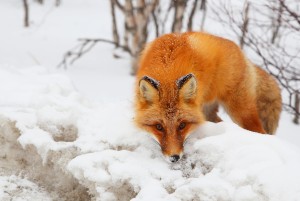
Wildlife Command Center Red Fox Capture and Removal Programs
Red Fox are perhaps the smartest and most versatile of all the fox species, they have learned to be very adaptable and populate almost every corner of the earth. Red Fox have an uncanny ability to survive and escape detection, given to human folk lore as the “Sly Fox”.

Red Fox are difficult to capture making removal a challange
Red Fox can see very well at night and have extremely good hearing and sense of smell. It can be very challenging to capture a red fox with traditional methods, Wildlife Command Center has developed over time a proven program to catch and relocate red fox that have started to cause problems for home owners.
Red Fox jumping into the snow head first
Wildlife Command Center 314-399-8272 can take care of all your Red Fox issues. Trapping and relocation programs to capture and release red fox that are creating a problem for homeowners.
Red foxes are found throughout a lot of of the hemisphere from the Arctic Circle to Central America, the mountains of central Asia, and northern Africa. This species is the widest distribution of any canine. Red foxes have additionally been introduced to Australia and also the Falkland Islands.
Red foxes utilize a large variety of habitats together with forest, savanna , prairie, deep desert, mountains, agriculture, and concrete areas. Red Fox like mixed vegetation communities, like edge habitats and mixed scrub and ground. they’re found from water level to 4700 meters elevation.
Coloration of red foxes ranges from pale chromatic red to deep burnt sienna on the higher elements and white, ash-gray or slaty on the face. The lower a part of the legs typically|is typically|is sometimes} black and also the tail usually encompasses a white or black tip. 2 color variants usually occur. Cross foxes have burnt sienna fur with a black stripe down the rear and another across the shoulders. Silver foxes vary from robust silver to just about black and are the foremost prized by furriers. These variants are concerning 27% and 15% of red fox people, severally. Red foxes, like several different canine species, have tail glands. In red fox this organ is found seventy seven metric linear unit higher than the foundation of the tail on its side and lies at intervals the corium and subcutaneous tissue. The eyes of mature animals are bright yellow. The prominent nose is dark black/brown or black. The dental formula is 3/3 1/1 4/4 2/3. The tooth row is more than [*fr1] the length of the skull. The premolars are straightforward and pointed, with the exception of higher fourth premolars, the carnassials. Molar structure emphasizes tearing and crushing. The mitt has five claws and also the pes four claws. the primary digit, or dew claw, is rudimentary however clawed and doesn’t contact the bottom.
Red foxes are the biggest of the Vulpes species. Head and body length ranges from 457 to 901 metric linear unit, tail length from 303 to 557 metric linear unit, and weight from four to fifteen metric weight unit. Males are slightly larger than females. Populations in southern deserts and in North America are much tinier than European populations in general. Body mass and length among populations additionally varies with latitude.

Wildlife Command Center Michael E Beran 314-399-8272 Red Fox
